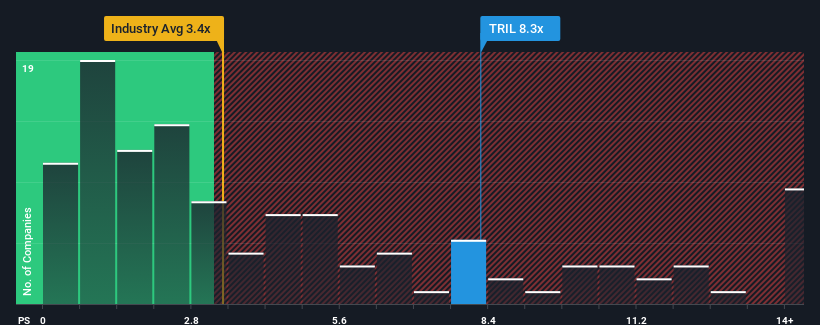- India
- /
- Electrical
- /
- NSEI:TARIL
Transformers and Rectifiers (India) Limited (NSE:TRIL) Stocks Shoot Up 31% But Its P/S Still Looks Reasonable
Transformers and Rectifiers (India) Limited (NSE:TRIL) shares have continued their recent momentum with a 31% gain in the last month alone. This latest share price bounce rounds out a remarkable 870% gain over the last twelve months.
Since its price has surged higher, when almost half of the companies in India's Electrical industry have price-to-sales ratios (or "P/S") below 3.4x, you may consider Transformers and Rectifiers (India) as a stock not worth researching with its 8.3x P/S ratio. Nonetheless, we'd need to dig a little deeper to determine if there is a rational basis for the highly elevated P/S.
See our latest analysis for Transformers and Rectifiers (India)

How Transformers and Rectifiers (India) Has Been Performing
Transformers and Rectifiers (India) could be doing better as its revenue has been going backwards lately while most other companies have been seeing positive revenue growth. It might be that many expect the dour revenue performance to recover substantially, which has kept the P/S from collapsing. If not, then existing shareholders may be extremely nervous about the viability of the share price.
Want the full picture on analyst estimates for the company? Then our free report on Transformers and Rectifiers (India) will help you uncover what's on the horizon.What Are Revenue Growth Metrics Telling Us About The High P/S?
In order to justify its P/S ratio, Transformers and Rectifiers (India) would need to produce outstanding growth that's well in excess of the industry.
Retrospectively, the last year delivered a frustrating 7.3% decrease to the company's top line. Still, the latest three year period has seen an excellent 74% overall rise in revenue, in spite of its unsatisfying short-term performance. Accordingly, while they would have preferred to keep the run going, shareholders would definitely welcome the medium-term rates of revenue growth.
Turning to the outlook, the next three years should generate growth of 47% per year as estimated by the two analysts watching the company. That's shaping up to be materially higher than the 22% per year growth forecast for the broader industry.
With this information, we can see why Transformers and Rectifiers (India) is trading at such a high P/S compared to the industry. It seems most investors are expecting this strong future growth and are willing to pay more for the stock.
What Does Transformers and Rectifiers (India)'s P/S Mean For Investors?
Shares in Transformers and Rectifiers (India) have seen a strong upwards swing lately, which has really helped boost its P/S figure. Generally, our preference is to limit the use of the price-to-sales ratio to establishing what the market thinks about the overall health of a company.
Our look into Transformers and Rectifiers (India) shows that its P/S ratio remains high on the merit of its strong future revenues. Right now shareholders are comfortable with the P/S as they are quite confident future revenues aren't under threat. Unless these conditions change, they will continue to provide strong support to the share price.
And what about other risks? Every company has them, and we've spotted 3 warning signs for Transformers and Rectifiers (India) (of which 1 makes us a bit uncomfortable!) you should know about.
Of course, profitable companies with a history of great earnings growth are generally safer bets. So you may wish to see this free collection of other companies that have reasonable P/E ratios and have grown earnings strongly.
Valuation is complex, but we're here to simplify it.
Discover if Transformers and Rectifiers (India) might be undervalued or overvalued with our detailed analysis, featuring fair value estimates, potential risks, dividends, insider trades, and its financial condition.
Access Free AnalysisHave feedback on this article? Concerned about the content? Get in touch with us directly. Alternatively, email editorial-team (at) simplywallst.com.
This article by Simply Wall St is general in nature. We provide commentary based on historical data and analyst forecasts only using an unbiased methodology and our articles are not intended to be financial advice. It does not constitute a recommendation to buy or sell any stock, and does not take account of your objectives, or your financial situation. We aim to bring you long-term focused analysis driven by fundamental data. Note that our analysis may not factor in the latest price-sensitive company announcements or qualitative material. Simply Wall St has no position in any stocks mentioned.
About NSEI:TARIL
Transformers and Rectifiers (India)
Manufactures and sells transformers in India.
Exceptional growth potential with outstanding track record.
Market Insights
Community Narratives




